The NVIDIA GeForce GTX 1660 Ti Review, Feat. EVGA XC GAMING: Turing Sheds RTX for the Mainstream Market
by Ryan Smith & Nate Oh on February 22, 2019 9:00 AM ESTPower, Temperature, and Noise
As always, we'll take a look at power, temperature, and noise of the GTX 1660 Ti, though as a pure custom launch we aren't expecting anything out of the ordinary. As mentioned earlier, the XC Black board has already revealed itself in its RTX 2060 guise.
As this is a new GPU, we will quickly review the GeForce GTX 1660 Ti's stock voltages and clockspeeds as well.
| NVIDIA GeForce Video Card Voltages | ||
| Model | Boost | Idle |
| GeForce GTX 1660 Ti | 1.037V | 0.656V |
| GeForce RTX 2060 | 1.025v | 0.725v |
| GeForce GTX 1060 6GB | 1.043v | 0.625v |
The voltages are naturally similar to the 16nm GTX 1060, and in comparison to pre-FinFET generations, these voltages are exceptionally lower because of the FinFET process used, something we went over in detail in our GTX 1080 and 1070 Founders Edition review. As we said then, the 16nm FinFET process requires said low voltages as opposed to previous planar nodes, so this can be limiting in scenarios where a lot of power and voltage are needed, i.e. high clockspeeds and overclocking. For Turing (along with Volta, Xavier, and NVSwitch), NVIDIA moved to 12nm "FFN" rather than 16nm, and capping the voltage at 1.063v.
| GeForce Video Card Average Clockspeeds | |||||
| Game | GTX 1660 Ti | EVGA GTX 1660 Ti XC |
RTX 2060 | GTX 1060 6GB | |
| Max Boost Clock |
2160MHz
|
2160MHz |
2160MHz
|
1898MHz
|
|
| Boost Clock | 1770MHz | 1770MHz | 1680MHz | 1708MHz | |
| Battlefield 1 | 1888MHz | 1901MHz | 1877MHz | 1855MHz | |
| Far Cry 5 | 1903MHz | 1912MHz | 1878MHz | 1855MHz | |
| Ashes: Escalation | 1871MHz | 1880MHz | 1848MHz | 1837MHz | |
| Wolfenstein II | 1825MHz | 1861MHz | 1796MHz | 1835MHz | |
| Final Fantasy XV | 1855MHz | 1882MHz | 1843MHz | 1850MHz | |
| GTA V | 1901MHz | 1903MHz | 1898MHz | 1872MHz | |
| Shadow of War | 1860MHz | 1880MHz | 1832MHz | 1861MHz | |
| F1 2018 | 1877MHz | 1884MHz | 1866MHz | 1865MHz | |
| Total War: Warhammer II | 1908MHz | 1911MHz | 1879MHz | 1875MHz | |
| FurMark | 1594MHz | 1655MHz | 1565MHz | 1626MHz | |
Looking at clockspeeds, a few things are clear. The obvious point is that the very similar results of the reference-clocked GTX 1660 Ti and EVGA GTX 1660 Ti XC are reflected in the virtually identical clockspeeds. The GeForce cards boost higher than the advertised boost clock, as is typically the case in our testing. All told, NVIDIA's formal estimates are still run a bit low, especially in our properly ventilated testing chassis, so we won't complain about the extra performance.
But on that note, it's interesting to see that while the GTX 1660 Ti should have a roughly 60MHz average boost advantage over the GTX 1060 6GB when going by the official specs, in practice the cards end up within half that span. Which hints that NVIDIA's official average boost clock is a little more correctly grounded here than with the GTX 1060.
Power Consumption
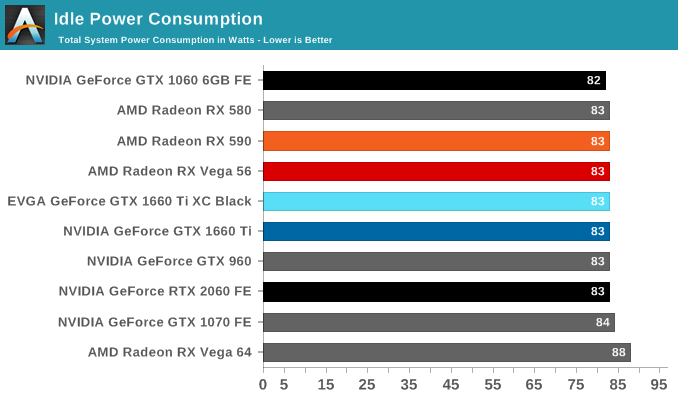

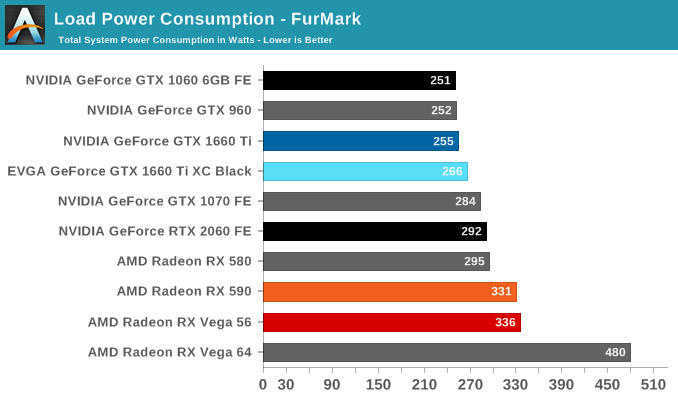
Even though NVIDIA's video card prices for the xx60 cards have drifted up over the years, the same cannot be said for their power consumption. NVIDIA has set the reference specs for the card at 120W, and relative to their other cards this is exactly what we see. Looking at FurMark, our favorite pathological workload that's guaranteed to bring a video card to its maximum TDP, the GTX 960, GTX 1060, and GTX 1660 are all within 4 Watts of each other, exactly what we'd expect to see from the trio of 120W cards. It's only in Battlefield 1 do these cards pull apart in terms of total system load, and this is due to the greater CPU workload from the higher framerates afforded by the GTX 1660 Ti, rather than a difference at the card level itself.
Meanwhile when it comes to idle power consumption, the GTX 1660 Ti falls in line with everything else at 83W. With contemporary desktop cards, idle power has reached the point where nothing short of low-level testing can expose what these cards are drawing.
As for the EVGA card in its natural state, we see it draw almost 10W more on the dot. I'm actually a bit surprised to see this under Battlefield 1 as well since the framerate difference between it and the reference-clocked card is barely 1%, but as higher clockspeeds get increasingly expensive in terms of power consumption, it's not far-fetched to see a small power difference translate into an even smaller performance difference.
All told, NVIDIA has very good and very consistent power control here. and it remains one of their key advantages over AMD, and key strengths in keeping their OEM customers happy.
Temperature
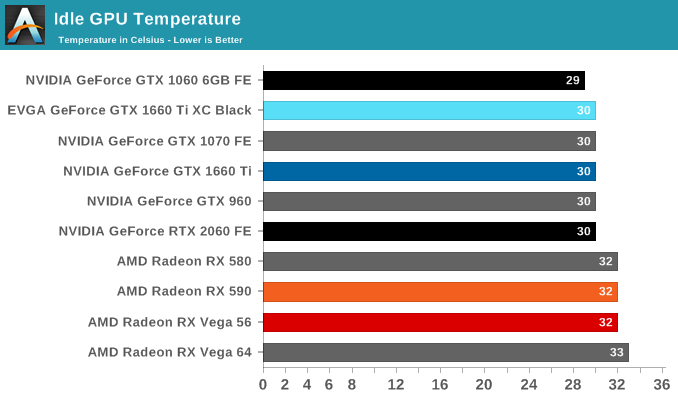
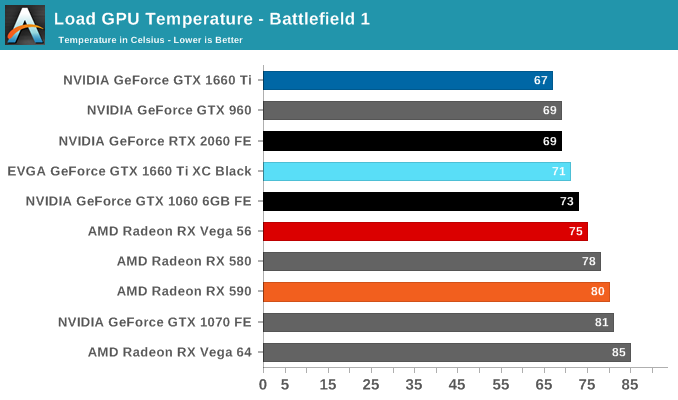

Looking at temperatures, there are no big surprises here. EVGA seems to have tuned their card for high performance cooling, and as a result the large, 2.75-slot card reports some of the lowest numbers in our charts, including a 67C under FurMark when the card is capped at the reference spec GTX 1660 Ti's 120W limit.
Noise

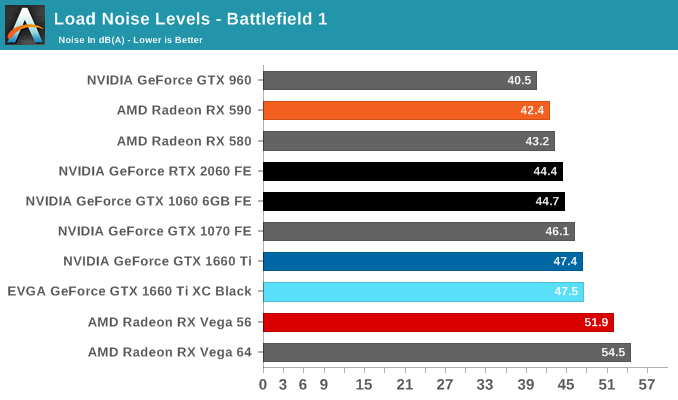

Turning again to EVGA's card, despite being a custom open air design, the GTX 1660 Ti XC Black doesn't come with 0db idle capabilties and features a single smaller but higher-RPM fan. The default fan curve puts the minimum at 33%, which is indicative that EVGA has tuned the card for cooling over acoustics. That's not an unreasonable tradeoff to make, but it's something I'd consider more appropriate for a factory overclocked card. For their reference-clocked XC card, EVGA could have very well gone with a less aggressive fan curve and still have easily maintained sub-80C temperatures while reducing their noise levels as well.










157 Comments
View All Comments
Rudde - Friday, February 22, 2019 - link
Never mind, the second page explains this well. (Parallell execution of fp16, fp32 and int32)CiccioB - Saturday, February 23, 2019 - link
Not only that.With Turing you also get mesh shading and a better support for thread switching, which is a awful technique used on GCN to improve its terrible efficiency, having lots of "bubbles" in the pipelines.
That's the reason you see previous AMD optimized games that didn't run too well with Pascal work much better with Turing, as the high threaded technique (the famous AC which is a bit overused in engines created for the console HW) is not going to constantly stall the SM with useless work as that of frequent task switching.
AciMars - Saturday, February 23, 2019 - link
“Worse yet, the space used per SM has gotten worse“. not true.. you know, turing have separate cuda cores for int and fp. It means when turing have 1536 cuda cores means 1536 int + 1536 fp cores. So on die size actually turing have 2x cuda cores compare to pascalCiccioB - Monday, February 25, 2019 - link
Not exactly, the number of CUDA core are the same, just that a new independent ALU as been added.A CUDA core is not only an execution unit, it also registers, memory (cache), buses (memory access) and other special execution units (load/store).
By adding a new integer ALU you don't automatically get double the capacity as really doubling the number of a complete CUDA core.
ballsystemlord - Friday, February 22, 2019 - link
Here are some spelling and grammar corrections.This has proven to be one of NVIDIA's bigger advantages over AMD, an continues to allow them to get away with less memory bandwidth than we'd otherwise expect some of their GPUs to need.
Missing d as in "and":
This has proven to be one of NVIDIA's bigger advantages over AMD, and continues to allow them to get away with less memory bandwidth than we'd otherwise expect some of their GPUs to need.
so we've only seen a handful of games implement (such as Wolfenstein II) implement it thus far.
Double implement, 1 befor ()s and 1 after:
so we've only seen a handful of games (such as Wolfenstein II) implement it thus far.
For our games, these results is actually the closest the RX 590 can get to the GTX 1660 Ti,
Use "are" not "is":
For our games, these results are actually the closest the RX 590 can get to the GTX 1660 Ti,
This test offers a slew of additional tests - many of which use behind the scenes or in our earlier architectural analysis - but for now we'll stick to simple pixel and texel fillrates.
Missing "we" (I suspect that the sentence should be reconstructed without the "-"s, but I'm not that good.):
This test offers a slew of additional tests - many of which we use behind the scenes or in our earlier architectural analysis - but for now we'll stick to simple pixel and texel fillrates.
"Looking at temperatures, there are no big surprises here. EVGA seems to have tuned their card for cooling, and as a result the large, 2.75-slot card reports some of the lowest numbers in our charts, including a 67C under FurMark when the card is capped at the reference spec GTX 1660 Ti's 120W limit."
I think this could be clarified as their are 2 EVGA cards in the charts and the one at 67C is not explicitly labeled as EVGA.
Thanks
Ryan Smith - Saturday, February 23, 2019 - link
Thanks!boozed - Friday, February 22, 2019 - link
The model numbers have become quite confusingYojimbo - Saturday, February 23, 2019 - link
I don't think they are confusing, 16 is between 10 and 20, plus the RTX is extra differentiation. In fact if NVIDIA had some cards in the 20 series with RTX capability and some cards in 20 series without RTX capability, even if some were 'GTX' and some were 'RTX', then that would be far more confusing. Putting the non-RTX Turing cards in their own series is a way of avoiding confusion. But if they actually come out with an "1180" as say some rumors floating around, that would be very confusing.haukionkannel - Saturday, February 23, 2019 - link
Interesting to see the next year.Rtx 3050 and gtx 2650ti for the weaker version, if we get one new card rtx family... Hmm... that could work if They keep the naming. 2021 RTX3040 and gtx 2640ti...
CiccioB - Thursday, February 28, 2019 - link
Next generation all cards will have enough RT and tensor core enabled.